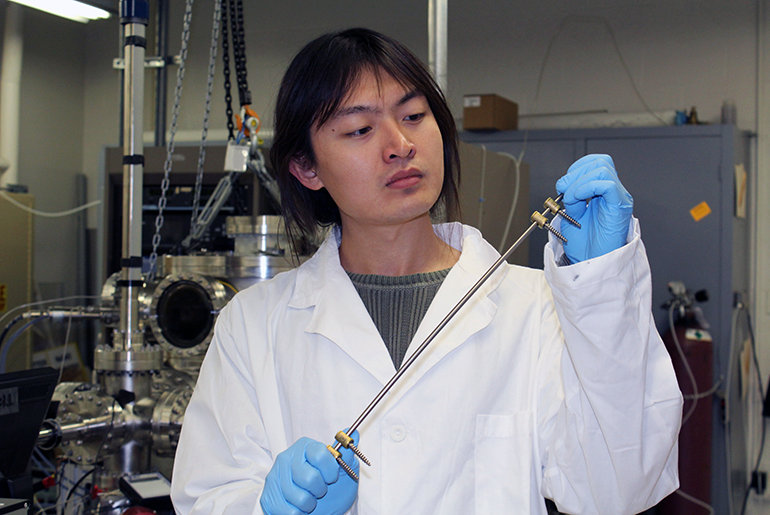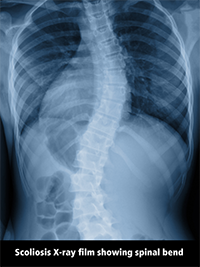
Scoliosis is typically defined as the curvature of the spine, which in severe cases can lead to severe physical deformity in addition to pulmonary and cardiac problems. Early-onset scoliosis refers to spine deformity that is present before 10 years of age.
Children with early-onset scoliosis often spend their entire childhood undergoing several surgical procedures to correct the curve in their spine. Surgeons implant metallic growing rods in the spine and expand them in bi-annual surgeries to keep up with the child’s growth. As the body moves, the screws attaching the rods to the bone become loose, increasing the chances of additional complicated surgeries to keep the rod in place.
Dr. Ji Ma, Texas A&M Engineering Experiment Station assistant research scientist, and Dr. Ibrahim Karaman, Chevron Professor I and head of the Department of Materials Science and Engineering at Texas A&M University, have designed a growing rod material that can significantly reduce the complications from corrective surgeries.
The material, a superelastic adaptive alloy, is five times more flexible than any currently available growing rod implants. It allows natural movement of the body and adjusts itself depending on the stress applied by the growing spine. This could potentially improve the success rate of the treatment.
Materials composing the implant are required to be biocompatible, fatigue and corrosion resistant, and they have to be compatible with the biomechanical environment of the patient’s body and the bone.

The bone is a living tissue that responds to the change in forces that arise once an implant is mechanically fixed to the skeleton. Unfortunately, the large mismatch between the mechanical properties of the metallic implants and the bone frequently result in complications, such as implant loosening, bone atrophy from stress shielding, and bone disease near implant extremities. These problems become increasingly important in young patients with osteoporotic or immature bones, where implant-related complication rates are markedly higher, the researchers say.
Using a series of thermo-mechanical processing steps, Ma and Karaman engineered a new titanium shape memory alloy. It possesses stress-dependent elastic properties that gradually decrease as the stress on it is increased.
“By modifying these properties to fit the biomechanical environment of the bone, it is now possible to create a device that satisfies the seemingly conflicting requirements of rigidity and flexibility required in growing rods,” said Ma.
The adaptive alloy allows growing rods to bend at the ends and stay stiff in the middle giving the necessary support to the spine. The patient’s natural movements stay flexible due to reduced friction and stress.
“This is not something you can do with all materials,” said Ma. “We preserve the strength and add flexibility to the implants without compromising the mechanical properties.”
Karaman’s National Science Foundation grant, “Design and In-vitro Characterization of Ni-free Biocompatible Shape Memory Alloys,” led to the present-day technology and its application in early onset scoliosis treatment. The researchers set out to develop a titanium-niobium alloy as an alternative to nickel titanium shape memory alloy since it has better biocompatibility and corrosion resistance similar to the human bone.
They later found evidence that nickel titanium alloy offered the same properties as the titanium niobium alloy. Currently, they are using both the alloys as candidates for the application in growing rods. The adaptive alloy is designed to have bio-inert constituents, less sensitivity to impurities and inclusions, better corrosion resistance, more stable fatigue response and predictable fatigue life.
Ma and Karaman are now working with Dr. Dennis Devito at Children’s Orthopedics of Atlanta to get a surgeon’s perspective on effective application of the technology.
“All children experience at least one complication during their treatment,” said Devito. “Ma and Karaman’s research offers a potential solution to some of the complications.”
The researchers have begun to commercialize the adaptive alloy technology. In 2015, they co-founded Adallo, LLC with Eric Flickinger, CEO at Meditech Spine LLC to develop prototype testing.
Top photo: Dr. Ji Ma with a sample of growing rod developed with the adaptive alloy technology at the Microstructural Engineering of Structural and Active Materials (MESAM) laboratory
